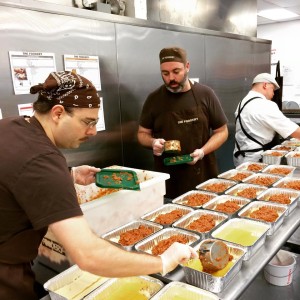One of the biggest challenges in the Good Food supply chain is getting products from farm and processor to market and consumer in a timely, efficient and cost-effective manner. The following is a contributed article by Suzanne Ma, co-founder of Routific, a logistics company that provides route optimization solutions for last-mile delivery fleets and has food businesses among its clients.
According to Ma, Routific “is saving businesses up to 40 percent on time and fuel.” She cited the company’s proprietary algorithm and user experience, and noted that Routific is proud to be a participant in the Techstars Chicago accelerator program.
by Suzanne Ma, co-founder of Routific, guest contributor
I’ve met so many Good Food producers who pour their heart and soul into growing, harvesting and preparing wholesome, delicious food. But getting that Good Food into the hands of consumers can be a challenge.
For many companies, this last crucial step in the supply chain — managing the transportation and delivery of the food — often goes neglected.
There’s a simple reason for this: you’re food experts. Food is your pride and joy. It’s why you got into this business in the first place. Logistics isn’t your expertise, and it really shouldn’t be.

The logo of the Routific delivery route optimization company.
Some Good Food producers outsource their delivery operations (hire a local carrier, courier or delivery service), but more and more businesses are seeing the value in hiring their own drivers. The latter is very capital-intensive, but it allows you, the producer, to at least have a hand in quality control.
Drivers, after all, are entrusted with delivering your products to your consumers. Quality control couldn’t be more important at this stage in the supply chain. Yet so little is done to ensure that delivery drivers are operating as efficiently as they can be.
Logistical Nightmare
We’ve sat with food delivery companies to observe how they manage their logistics. Many of them don’t — at least, not very well.
We’ve watched business owners spend two to three hours a day manually planning routes by hand (an epic waste of time!), while others rely solely on driver experience to guide their decisions.
“We started out using pencil and paper, and going by zip code,” said John Bauer, co-founder of Boston’s The Foodery. “We sent drivers out who were familiar with the area and we relied on people’s expertise.”

Employees of The Foodery in Boston prepare meals for delivery.
In addition to navigating through traffic, drivers have to cram a lot into their heads: the order of deliveries, special instructions for customers, what time they need to make each drop, and much more. Drivers also now play an important role in building customer relationships.
The team at The Foodery went to great lengths to ensure that deliveries went smoothly. They offered higher wages in an effort to hire quality, trustworthy ambassadors to deliver their meals, which are hand-crafted and made from organic and locally sourced food producers.
But as the business grew, it became clear that depending on individual drivers to help execute increasingly complex logistics was bottlenecking the business. They needed to establish a streamlined process to ensure a consistent and efficient delivery process.
Tick-Tock
When it comes to delivering food — whether it’s fresh produce or hot meals — everything comes down to time.
Kevin Black, co-owner of Lee & Maria’s Market in Kingsville, Ontario, put it this way:
“Time is money. If we have a box of produce that sits for an extra half hour in our vans, that can affect the quality of our fruits and vegetables. Our customer suffers and we suffer,” said Black, who began investigating quick and efficient methods to help his delivery fleet bring fresh farm produce to hundreds of homes.
Bauer, at The Foodery, was looking for a better solution, too.
“Nothing will shut a food company faster if someone comes down and blows the whistle on a food-borne illness,” he said. “Everything is in our control when we’re in the kitchen, but we needed to stay vigilant the minute those deliveries went out the door.”
Route Optimization
Black and Bauer went online and Googled two words: “Route Optimization.” They quickly discovered software could plan delivery routes for them in seconds.
The software optimized routes for their entire fleet, taking into account delivery time windows and the capacities of the trucks. It also maximized use of their drivers, gave accurate ETAs, and dispatched those optimal routes to driver smart phones via a mobile app.
“There are so many good reasons why route optimization is better than a human route planner,” Bauer explained. “As our business grows, we’re dealing with more and more The addresses. Route optimization will sequence our addresses in order, and that helps us create a workflow. We pack our delivery vans in the order in which they’re going to be emptied out on the delivery route. You can’t imagine what a great deal of efficiency that adds to the operation.”
Black said route optimization enabled him to modernize his in-laws’ family business. By offering a home delivery service, the farm is now busier than ever.
Route optimization “shows us the fastest, most efficient way to make all our deliveries,” Black said. “Our produce arrives fresh, and that kind of service brings our customers back to us again and again.”

Luke Saunders, the founder and owner of Farmer’s Fridge in Chicago, utilizes route optimization to get fresh jarred salads and other food preparations through city traffic to his company’s vending machines around town.
Chicago’s very own Farmer’s Fridge began routing their delivery fleet with route optimization software last year. Founder Luke Saunders said there was an obvious return on investment after they adopted the solution into their workflow.
Route optimization “has allowed us to optimize our routes to conserve fuel, while increasing driver efficiency and reducing the workload on our logistics department,” Saunders said. “As a result, we can focus our energy on our core mission, which is to make healthy food more accessible around the city of Chicago and beyond.”
[Good Food on Every Table recently published a profile of Farmer’s Fridge. To read it, please click here.]
Get Back to What You Love
So drop that pen and paper, get rid of those maps, and stop trying to be a logistics expert. There are solutions out there that can take care of the manual work in seconds, eliminate the guesswork, and outperform even the most experienced route planners and drivers.
Food is your calling, and it deserves all the love and attention you have to give.
Learn more about how Routific helps food delivery businesses optimize their logistics here.
